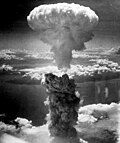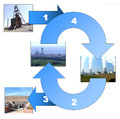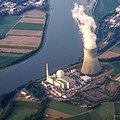Portal:Nuclear technology
The Nuclear Technology Portal
Introduction

- Nuclear technology is technology that involves the nuclear reactions of atomic nuclei. Among the notable nuclear technologies are nuclear reactors, nuclear medicine and nuclear weapons. It is also used, among other things, in smoke detectors and gun sights. (Full article...)
- Nuclear power is the use of nuclear reactions to produce electricity. Nuclear power can be obtained from nuclear fission, nuclear decay and nuclear fusion reactions. Presently, the vast majority of electricity from nuclear power is produced by nuclear fission of uranium and plutonium in nuclear power plants. Nuclear decay processes are used in niche applications such as radioisotope thermoelectric generators in some space probes such as Voyager 2. Reactors producing controlled fusion power have been operated since 1958 but have yet to generate net power and are not expected to be commercially available in the near future. (Full article...)
- A nuclear weapon is an explosive device that derives its destructive force from nuclear reactions, either nuclear fission (fission or atomic bomb) or a combination of fission and nuclear fusion reactions (thermonuclear weapon), producing a nuclear explosion. Both bomb types release large quantities of energy from relatively small amounts of matter. (Full article...)
General images -
Selected article -
The laboratory was established in February 1942 to study and use the newly discovered chemical element plutonium. It researched plutonium's chemistry and metallurgy, designed the world's first nuclear reactors to produce it, and developed chemical processes to separate it from other elements. In August 1942 the lab's chemical section was the first to chemically separate a weighable sample of plutonium, and on 2 December 1942, the Met Lab produced the first controlled nuclear chain reaction, in the reactor Chicago Pile-1, which was constructed under the stands of the university's old football stadium, Stagg Field.
The Metallurgical Laboratory was established as part of the Metallurgical Project, under the S-1 Committee, and also known as the "Pile" or "X-10" Project, headed by Chicago professor Arthur H. Compton, a Nobel Prize laureate. In turn, it became part of the Manhattan Project – the Allied effort to develop the atomic bomb during World War II. The Metallurgical Laboratory was successively led by Richard L. Doan, Samuel K. Allison, Joyce C. Stearns and Farrington Daniels. Scientists who worked there included Enrico Fermi, James Franck, Eugene Wigner, Glenn Seaborg and Leo Szilard. Compton assigned Robert Oppenheimer to take over the research into bomb design in June 1942, and that became the separate Project Y in November. At its peak on 1 July 1944, the Met Lab had 2,008 staff.
Chicago Pile-1 was soon moved by the lab to Site A, a more remote location in the Argonne Forest preserves, where the original materials were used to build an improved Chicago Pile-2 to be employed in new research into the products of nuclear fission. Another reactor, Chicago Pile-3, was built at the Argonne site in early 1944. This was the world's first reactor to use heavy water as a neutron moderator. It went critical in May 1944, and was first operated at full power in July 1944. The Metallurgical Laboratory also designed the X-10 Graphite Reactor at the Clinton Engineer Works in Oak Ridge, Tennessee, and the B Reactor at the Hanford Engineer Works in the state of Washington.
As well as the work on reactor development, the Metallurgical Laboratory studied the chemistry and metallurgy of plutonium, and worked with DuPont to develop the bismuth phosphate process used to separate plutonium from uranium. When it became certain that nuclear reactors would involve radioactive materials on a gigantic scale, there was considerable concern about the health and safety aspects, and the study of the biological effects of radiation assumed greater importance. It was discovered that plutonium, like radium, was a bone seeker, making it especially hazardous. The Metallurgical Laboratory became the first of the national laboratories, the Argonne National Laboratory, on 1 July 1946. The work of the Met Lab also led to the creation of the Enrico Fermi Institute and the James Franck Institute at the university. (Full article...)
Selected picture -
Did you know?
- ... that 1ES 1927+654, a galaxy in Draco, exhibited such extreme nuclear activity that it challenged conventional models of black-hole environments?
- ... that the 1991 Andover tornado narrowly avoided hitting two warplanes equipped with nuclear warheads?
- ... that the Russian and Belarussian military exercise Zapad 2009 involved nuclear-capable ballistic missiles?
- ... that according to witnesses, the plutonium charge in the bomb used in the nuclear weapons test Gerboise Verte was transported in an economy car?
- ... that Project Ketch proposed the detonation of a 24-kiloton nuclear device in Pennsylvania to create a natural-gas storage reservoir?
- ... that the British Tychon missile was developed from a Barnes Wallis concept to keep strike aircraft safe while dropping nuclear bombs?
Related WikiProjects
Things you can do
| Parts of this portal (those related to section) need to be updated. Please help update this portal to reflect recent events or newly available information. Relevant discussion may be found on the talk page. (September 2021) |
|
Here are some Open Tasks :
|
Selected biography -
Daghlian was irradiated as a result of a criticality accident that occurred when he accidentally dropped a tungsten carbide brick onto a 6.2 kg bomb core made of plutonium–gallium alloy. This core, subsequently nicknamed the "demon core", was later involved in the death of another physicist, Louis Slotin. (Full article...)
Nuclear technology news
- 1 August 2025 – Russian invasion of Ukraine
- U.S. president Donald Trump orders the deployment of two United States Navy nuclear submarines near Russia for potential military action against Russian forces in response to statements made by former Russian president Dmitry Medvedev and current deputy chairman of the Security Council of the Russian Federation regarding Trump's previously-stated deadline for ending the war in Ukraine. (Reuters) (BBC News)
Related portals
Related topics
Subcategories
Associated Wikimedia
The following Wikimedia Foundation sister projects provide more on this subject:
-
Commons
Free media repository -
Wikibooks
Free textbooks and manuals -
Wikidata
Free knowledge base -
Wikinews
Free-content news -
Wikiquote
Collection of quotations -
Wikisource
Free-content library -
Wikiversity
Free learning tools -
Wiktionary
Dictionary and thesaurus


























































































